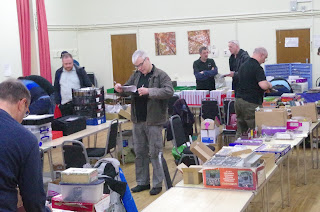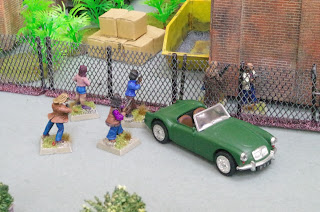I mentioned a few posts ago that I had been developing some modifications to Sharp Practice so that I could fight large scale battles using my NYW armies, which were based up for FOG:R rules.
Last Sunday at the club I had the chance to play through a battle using these mods, the idea being to playtest what I'd written and see where I needed to tweak them to make them more playable. So, many thanks to Clive, who took the role of the Anglo-Dutch commander. I commanded the French.
The battlefield was relatively open, giving the opportunity to manoeuvre the troops more easily.
The Anglo-Dutch arrived first, with a brigade containing dragoons heading towards the French left.
French troops, also containing dragoons quickly deployed to counter them.
Note the Dutch Garde Te Voet, with their regimental gun.
On the right, regiments of Horse began to advance, with Woods' Horse (green standard) receiving fire from the Fimarcon Dragoons.
Elsewhere the Régiment de Villeroy charges the Dutch Nassau Horse in column. Over here on the French right flank, the Horse continue to advance until stopped by accurate Anglo-Scottish musketry.
Woods Horse charge the French Dragoons, wiping them out.
The French camp is a mere canter away now.
The Anglo-Scottish Brigade arrives, supported by guns and Fusiliers.
Woods' Horse attack the French camp but are beaten off by musket fire from the Fusiliers du Roi.
This allows the main body of the French army to deploy, including the Gardes Françaises and the Régiment du Roi, both resplendent in blue uniforms.
Woods' Horse are powerless and take casualties from short-range musketry.
Lumley's Horse advance, supported by the Garde Te Voet
The Anglo-Dutch Horse are in the thick of it as the Régiment de Navarre are in combat against the Earl of Oxford's Horse
However, as the Régiment de Rohan reinforce the French left, threatening to charge the English dragoons a stalemate develops.
The battlefield is becoming congested but the French centre looks strong.
Eventually, we had to call it a day as we ran out of time.
So, an inconclusive result, which is kind of appropriate for the period. Many battles ended up with neither side having the upper hand, which is why there were so many sieges and a lot of fruitless marching and counter-marching to try and gain an advantage.
Some notes about the playtesting. Firstly, it was great to have the chance to see how my ideas worked out in an actual battle. Early on, it became apparent that my initial ideas gave the Horse far too many advantages in Fisticuffs, so I amended them as the game progressed, which evened things out a lot. We also agreed that the standard rules for artillery in SP made the guns far too powerful, so we agreed to halve the number of dice rolled for each gun. This gave a much better result.
We also decided that troops formed up in column should be allowed a D6+3 move, rather than a simple D6, but that they would only be allowed to use the front two bases in Fisticuffs.
I think that we will need to play through these amendments again, but overall, these changes do seem to make for a fairly reasonable game with large armies that look attractive on the table.


















































